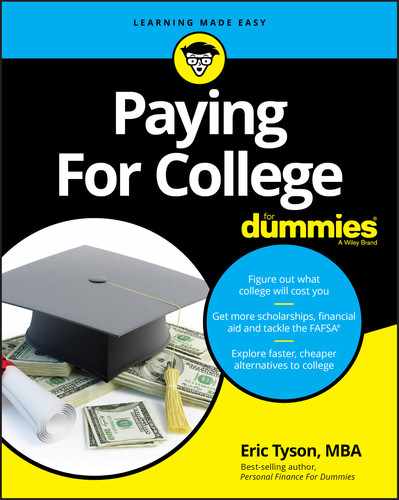Discover a concrete financial plan to finance a college education Financing a college education is a daunting task no matter what your circumstances. Bestselling author and personal finance expert, Eric Tyson offers tried and true strategic advice on how to understand loans, know your options, and how to improve your financial fitness while paying down your student loan debt. Armed with the checklists and timelines, you’ll be able to: Paying for College For Dummies helps parents and independent students navigate everything from planning strategically as a married/separated/divorced/widowed parent, completing every question on the FAFSA and CSS PROFILE forms, understanding tax laws, and so much more. No other book offers this much practical guidance on choosing and paying or college.
Table of Contents
- Cover
- Introduction
- Part 1: Understanding Paying for College
- Chapter 1: Confronting High College Prices and the Modern Job Market
- Confronting the High Prices of Higher Education
- Looking at How College Pricing Works
- Employment Reality and What Students Say They Want from College
- Looking at How the Higher Education Landscape is Changing
- Chapter 2: Financial Planning Steps When Your Kids are Young
- Kids Are Costly! Getting Your Finances in Order
- Finding Saving Methods Given How College Financial Aid Works
- Spending on Your Kids without Breaking the Bank
- Keeping Spending in Line: Using Youth Sports as an Example
- Completing the Personal Finance Olympics of Childrearing
- Chapter 3: Exposing Your Kids to Work, Finances, and the “Real World”
- Laying the Foundation for Raising Money-Smart Kids in the Early Years
- Dealing with What Kids Are Exposed To
- Developing the Work-Money Connection
- Teaching Your Kids About More Real-World Money Topics
- Part 2: Finding Acceptance
- Chapter 4: Making the Most of Your Kid’s Academic and Outside Experiences
- Understanding the Value of Academic Success (Good Grades)
- Jumping Through Hoops: Marketing of High School Students
- Chapter 5: Guiding Your Child
- Agreeing to a Process for Making Decisions
- Conducting the Right Research
- Working with and Hiring “Experts”
- Dealing with Mental Health Issues
- Part 3: Confronting College Costs: Traditional Colleges and Alternatives
- Chapter 6: Seeing How Traditional Colleges Decide What to Charge You
- Taking All Your (Financial) Clothes OFF!
- Valuing Wanting One Another
- Checking on Realities for Recruited Athletes
- Chapter 7: Surveying the Range of College Options
- Considering Four-Year Colleges
- Learning and Serving in the Military
- Considering Community Colleges
- Taking a Year Post–High School to Work or Volunteer
- Is College Necessary or the Best Option for Your Children?
- Chapter 8: The Best College Alternatives to Consider
- Looking at Last-Mile Programs
- Getting Oriented with Online Programs
- Finding Out about Vocational/Trade Schools
- Final Thoughts on Alternatives to Traditional Colleges
- Part 4: Getting the Best Education at the Best Price
- Chapter 9: Financial Steps You Should Take While Your Kids Grow Up
- Determining a College Financial Aid Package
- Looking into Long-Term Saving and Investing Strategies
- Strategizing to Pay for Educational Expenses
- Determining Later-Year Savings Tactics
- Chapter 10: Filling Out the Common Financial Aid Forms to Your Best Advantage
- Determining Whether to Apply for Financial Aid
- Taking an Overview of Financial Aid Forms
- Filling Out the FAFSA® Form: Free Application for Federal Student Aid
- Getting on Board with the CSS Profile Form
- Checking Off School-Specific Forms
- Chapter 11: Tricks and Tips for Finding Scholarships and Borrowing Money
- Gaining Grants and Scholarships
- Borrowing for College
- Chapter 12: Reviewing Financial Aid Offers and Appealing Them
- Getting Word on College Acceptances and Doing More Research
- Taking a Long, Hard Look at the Bottom-Line Price
- Part 5: The Part of Tens
- Chapter 13: (Almost) Ten Education Tax Breaks and Rules You Should Know About
- Contributing to Retirement Accounts
- Checking to See if You Qualify for the Saver’s Tax Credit
- Understanding the Tax Benefits of 529 Plans
- Considering Coverdell Education Savings Accounts (ESAs)
- Utilizing the American Opportunity Tax Credit
- Taking Advantage of the Lifetime Learning Credit
- Understanding the Retirement Account Withdrawal Penalty Waiver
- Finishing on Time without High Income Earning Years
- Taking the Student Loan Interest Deduction
- Chapter 14: Ten Tips for Getting Your College Degree Quicker
- Communicating Is Key
- Keeping All Your Options Open
- Planning Ahead Financially
- Picking Colleges with High Graduation Rates
- Selecting Colleges that Offer Your Desired Courses and Majors
- Choosing Schools with Affordable Housing
- Getting College Credit in High School
- Making Use of Advisors and Deans
- Having Students Work during College
- Avoiding Stopping School to Work
- Chapter 15: Ten Important Money Management Steps for Young Adults
- Getting Financially Fit, Now!
- Adapting and Adjusting Along the Way
- Cancelling Consumer Credit
- Reviewing Your Budget and Spending Plans
- Striving to Regularly Save and Invest
- Ensuring that You’re Properly Insured
- Continuing Your Education
- Always Being Prepared for a Job Change
- Evaluating the Total Cost of Relocating
- Ensuring Compatibility when Picking a Partner
- Chapter 16: Ten Things to Know About Student Loans
- Keeping Track of Your Loans
- Understanding What Cosigners Means for Responsibility
- Knowing the Loan Terms
- Using the Auto-Pay Feature to Save Money
- Understanding Loan Forgiveness Conditions
- Knowing Your Federal Loan Repayment Options
- Cautiously Considering Refinance Possibilities
- Asking for Relief
- Making Use of the Student Loan Interest Deduction
- Pausing Your Loans with a Return to Higher Education
- Index
- About the Author
- Advertisement Page
- Connect with Dummies
- End User License Agreement
